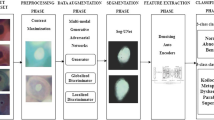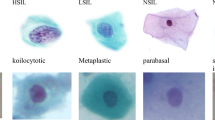Abstract
Cervical cancer is one of the curable cancers when it is diagnosed in the early stages. Pap smear test and visual inspection using acetic acid are the most common screening mechanism for the cervical lesion to categorize the cervical cells as normal, precancerous, or cancerous. However, most of the classification methods success depends on the accurate spotting and segmenting of cervical location. These challenges pave the way for sixty years of research in cervical cancer diagnosis, but still, accurate spotting of the cervical cell remains an open challenge. Moreover, state-of-the-art classification methods are developed based upon the extraction of manual annotations of features. In this paper, an effective hybrid deep learning technique using Small-Object Detection-Generative Adversarial Networks (SOD-GAN) with Fine-tuned Stacked Autoencoder (F-SAE) is developed to address the shortcomings mentioned above. The generator and discriminator of the SOD-GAN are developed using Region-based Convolutional Neural Network (RCNN). The model parameters are fine-tuned using F-SAE, and the hyperparameters of the SOD-GAN are normalized and optimized to make the lesion detection faster. The proposed approach automatically detects and classifies the cervical premalignant and malignant conditions based on deep features without any preliminary classification and segmentation assistance. Extensive experimentation has also been done with multivariate heterogeneous data, and the proposed approach has shown promising improvement in efficiency and reduces the time complexity.













Similar content being viewed by others
References
Aina OE, Adeshina SA, Aibinu AM (2019) Deep learning for image-based cervical Cancer detection and diagnosis—a survey. In 2019 15th international conference on electronics, computer, and computation (ICECCO) 2019 Dec 10 (pp. 1-7). IEEE.
Al-Wesabi YM, Choudhury A, Won D (2018) Classification of cervical cancer dataset, Proceedings of the 2018 IISE Annual Conference, Orlando, pp. 1456–1461
Bagcchi S (2016) India launches plan for national cancer screening programme: i5574.
Bai Y, Zhang Y, Ding M, Ghanem B (2018) SOD-GAN: Small object detection via multi-task generative adversarial network. In Proceedings of the European Conference on Computer Vision (ECCV) (pp. 206–221).
Bailey HH, Chuang LT, DuPont NC, Eng C, Foxhall LE, Merrill JK (2016) American society of clinical oncology statement: Human papillomavirus vaccination for cancer prevention. Journal of Clinical Oncology 34(15):1803–1812
Cancer Genome Atlas Research Network (2017 Mar) Integrated genomic and molecular characterization of cervical cancer. Nature. 543(7645):378–384
Chandran KP, Kumari UR (2015) Improving cervical cancer classification on MR images using texture analysis and probabilistic neural network. IJSETR 4(9)
Dasari S, Wudayagiri R, Valluru L (2015) Cervical cancer: biomarkers for diagnosis and treatment. Clin Chim Acta 445:7–11
De Martel C, Plummer M, Vignat J, Franceschi S (2017) Worldwide burden of cancer attributable to HPV by site, country and HPV type. Int J Cancer 141(4):664–670
Deng SP, Zhu L, Huang DS (2015 Sep 25) Predicting hub genes associated with cervical cancer through gene co-expression networks. IEEE/ACM Transactions on Computational Biology and Bioinformatics 13(1):27–35
Fatlawi HK (2017) Enhanced classification model for cervical Cancer dataset based on cost sensitive classifier. International Journal of Computer Techniques 4(4)
Fernandes K, Cardoso JS, Fernandes J (2017) Transfer learning with partial observability applied to cervical cancer screening. Springer International Publishing, Iberian Conference on Pattern Recognition and Image Analysis
Ghebre RG, Grover S, Xu MJ, Chuang LT, Simonds H (2017) Cervical cancer control in HIV-infected women: past, present and future. Gynecologic oncology reports 21:101–108
Hu Z, Tang J, Wang Z, Zhang K, Zhang L, Sun Q (2018 Nov 1) Deep learning for image-based cancer detection and diagnosis− a survey. Pattern Recogn 83:134–149
Hu L, Bell D, Antani S, Xue Z, Yu K, Horning MP, Gachuhi N, Wilson B, Jaiswal MS, Befano B, Long LR (2019 Sep 1) An observational study of deep learning and automated evaluation of cervical images for cancer screening. JNCI: Journal of the National Cancer Institute 111(9):923–932
Jantzen J, Norup J, Dounias G, Bjerregaard B (2005) Pap-smear benchmark data for pattern classification. Nature inspired Smart Information Systems (NiSIS 2005)
Li C, Xue D, Zhou X, Zhang J, Zhang H, Yao Y, Kong F, Zhang L, Sun H (2019) Transfer learning based classification of cervical cancer immunohistochemistry images. In Proceedings of the Third International Symposium on Image Computing and Digital Medicine 2019 Aug 24 (pp. 102–106).
Oak P, Iyer B (2020) Specular reflection detection for early prediction of cervix Cancer. In Emerging trends in electrical, communications, and information technologies (pp. 683-691). Springer, Singapore.
Obukhova NA, Motyko AA, Kang U, Bae SJ, Lee DS (2017) Automated image analysis in multispectral system for cervical cancer diagnostic Open innovations association (FRUCT), 2017 20th conference of, IEE, pp. 345–351
Sato M, Horie K, Hara A, Miyamoto Y, Kurihara K, Tomio K, Yokota H (2018 Mar 1) Application of deep learning to the classification of images from colposcopy. Oncol Lett 15(3):3518–3523
Singh SK, Goyal A (2020 Apr 1) Performance analysis of machine learning algorithms for cervical Cancer detection. International Journal of Healthcare Information Systems and Informatics (IJHISI) 15(2):1–21
Torheim T, Malinen E, Hole KH, Lund KV, Indahl UG, Lyng H, Kvaal K, Futsaether CM (2017 May 4) Autodelineation of cervical cancers using multiparametric magnetic resonance imaging and machine learning. Acta Oncol 56(6):806–812
Wang P, Wang L, Li Y, Song Q, Lv S, Hu X (2019 Feb 1) Automatic cell nuclei segmentation and classification of cervical pap smear images. Biomedical Signal Processing and Control 48:93–103
William W, Ware A, Basaza-Ejiri AH, Obungoloch J (2018 Oct 1) A review of image analysis and machine learning techniques for automated cervical cancer screening from pap-smear images. Comput Methods Prog Biomed 164:15–22
Win KP, Kitjaidure Y, Paing MP, Hamamoto K (2019) Cervical cancer detection and classification from pap smear images. In Proceedings of the 2019 4th International Conference on Biomedical Imaging, Signal Processing 2019 Oct 17 (pp. 47–54).
Wu W, Zhou H (2017) Data-driven diagnosis of cervical Cancer with support vector machine based approaches. IEEE Access 5:25189–25195
Zhang L, Lu L, Nogues I, Summers RM, Liu S, Yao Deeppap J (2017) Deep convolutional networks for cervical cell classification. IEEE Journal of Biomedical and Health Informatics 21(6):1633–1643
Author information
Authors and Affiliations
Corresponding author
Ethics declarations
Conflict of interest
The authors declared that there is no conflict of interest regarding the publication of this research article. The author certifies that they do not have any entity with any financial interest in the subject matter or materials discussed in this manuscript.
Additional information
Publisher’s note
Springer Nature remains neutral with regard to jurisdictional claims in published maps and institutional affiliations.
Rights and permissions
About this article
Cite this article
Elakkiya, R., Teja, K.S.S., Jegatha Deborah, L. et al. Imaging based cervical cancer diagnostics using small object detection - generative adversarial networks. Multimed Tools Appl 81, 191–207 (2022). https://doi.org/10.1007/s11042-021-10627-3
Received:
Revised:
Accepted:
Published:
Issue Date:
DOI: https://doi.org/10.1007/s11042-021-10627-3




